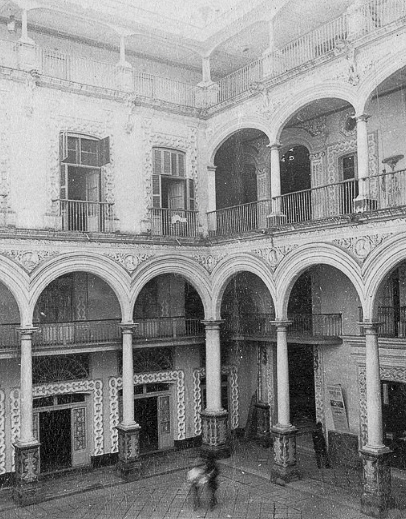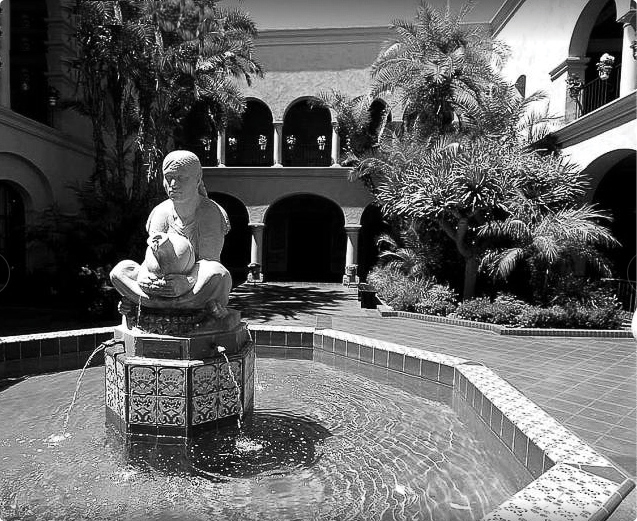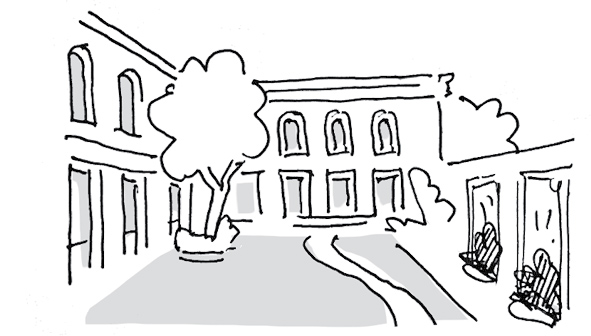9.3. Courtyard Building
Aus Pattern Language Wiki
When laying out the Perimeter Block, conceive of the block as a series of courtyards, with some of them penetrating into individual buildings.
Problem-statement: In busy neighborhoods, there is a need for quiet outdoor space that is part of the building, and for light and air to enter the rooms in the middle of the building. This is the archetypal courtyard building.
Discussion: We have already discussed why the Perimeter Block is a beneficial pattern, providing an urban connection on one side and private outdoor space on the other. Here we jump down one scale to the individual building that encloses a courtyard, providing the same benefits at a smaller scale.
Courtyard buildings can be seen across many cultures and climates including colder climates, where they typically form small outdoor spaces of L-shaped or U-shaped buildings. In hotter climates, courtyard buildings are often O-shaped, with the outdoor space completely surrounded by the building. In some cases, there are multiple courtyards within the same building.
Courtyard buildings do pose some challenges, including a larger exterior wall area requiring additional insulation in buildings that require heating or cooling. Some courtyard buildings employ operable or retractable roofs over the courtyard, including glazed roofs.
Not often mentioned is the remarkable energy and comfort performance that a courtyard building can achieve (able to remain relatively cool in warm weather, and warmer in cool weather, without high consumption of fuels or other resources)1. It was largely for this reason, as well as for qualities of natural light and ventilation, that the pattern can be seen independently in so many traditional building cultures. In addition, courtyard buildings bring sunlight (modulated by shading devices) directly into otherwise deep buildings.
.The performance of courtyard buildings can be improved with galleries or porches along one or more sides of the courtyard, shading from excessive sun, and also forming a connecting transition zone.
Therefore:
When buildings become too deep to admit air and light, or when they would benefit from private outdoor space within them, lay them out as courtyard buildings. Create porches fronting them, or wrapping two or more sides. If the courtyards are not entirely enclosed by buildings, enclose them with appropriate walls or fences, so that they function as private outdoor spaces.
Create Indoor-Outdoor Ambiguity within the courtyard building, by using fully or partially glazed roofs. Create a Circulation Network within the spaces surrounding the courtyard. …
¹ The energy performance of courtyard buildings in different climates has been widely studied. See for example Aldawoud, A. (2008). Thermal performance of courtyard buildings. Energy and Buildings, 40(5), 906-910.
Mehaffy, M. et al. (2020). COURTYARD BUILDING (pattern). In A New Pattern Language for Growing Regions. The Dalles: Sustasis Press. Available at https://pattern-language.wiki/.../Courtyard_Building
SECTION I:
PATTERNS OF SCALE
1. REGIONAL PATTERNS
Define the large-scale spatial organization…
1.4. 400M THROUGH STREET NETWORK
2. URBAN PATTERNS
Establish essential urban characteristics…
3. STREET PATTERNS
Identify and allocate street types…
4. NEIGHBORHOOD PATTERNS
Define neighborhood-scale elements…
5. SPECIAL USE PATTERNS
Integrate unique urban elements with care…
6. PUBLIC SPACE PATTERNS
Establish the character of the crucial public realm…
7. BLOCK AND PLOT PATTERNS
Lay out the detailed structure of property lines…
8. STREETSCAPE PATTERNS
Configure the street as a welcoming place…
9. BUILDING PATTERNS
Lay out appropriate urban buildings…
10. BUILDING EDGE PATTERNS
Create interior and exterior connectivity…
10.1. INDOOR-OUTDOOR AMBIGUITY
SECTION II:
PATTERNS OF MULTIPLE SCALE
11. GEOMETRIC PATTERNS
Build in coherent geometries at all scales…
11.2. SMALL GROUPS OF ELEMENTS
12. AFFORDANCE PATTERNS
Build in user capacity to shape the environment…
13. RETROFIT PATTERNS
Revitalize and improve existing urban assets …
14. INFORMAL GROWTH PATTERNS
Accommodate “bottom-up” urban growth…
15. CONSTRUCTION PATTERNS
Use the building process to enrich the result…
SECTION III:
PATTERNS OF PROCESS
16. IMPLEMENTATION TOOL PATTERNS
Use tools to achieve successful results…
16.2. ENTITLEMENT STREAMLINING
16.3. NEIGHBORHOOD PLANNING CENTER
17. PROJECT ECONOMICS PATTERNS
Create flows of money that support urban quality…
17.4. ECONOMIES OF PLACE AND DIFFERENTIATION
18. PLACE GOVERNANCE PATTERNS
Processes for making and managing places…
18.3. PUBLIC-PRIVATE PLACE MANAGEMENT
19. AFFORDABILITY PATTERNS
Build in affordability for all incomes…
19.1. INTEGRATED AFFORDABILITY
20. NEW TECHNOLOGY PATTERNS
Integrate new systems without damaging old ones…
20.2. RESPONSIVE TRANSPORTATION NETWORK COMPANY


